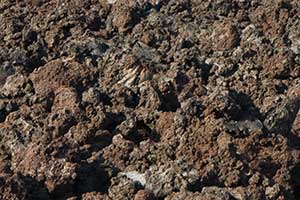 |
`A`a Lava
`A`a (pronounced "ah-ah") is a Hawaiian term for lava flows that have a rough rubbly surface composed of broken lava blocks called clinkers. The incredibly spiny surface of a solidified `a`a flow makes walking very difficult and slow. The clinkery surface actually covers a massive dense core, which is the most active part of the flow. As pasty lava in the core travels downslope, the clinkers are carried along at the surface. At the leading edge of an `a`a flow, however, these cooled fragments tumble down the steep front and are buried by the advancing flow. This produces a layer of lava fragments both at the bottom and top of an `a`a flow. |
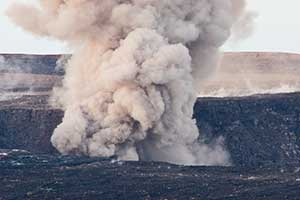 |
Ash
Volcanic ash consists of rock, mineral, and volcanic glass fragments smaller than 2 mm (0.1 inch) in diameter, which is slightly larger than the size of a pinhead. Volcanic ash is not the same as the soft fluffy ash that results from burning wood, leaves, or paper. It is hard, does not dissolve in water, and can be extremely small--ash particles less than 0.025 mm (1/1,000th of an inch) in diameter are common. Ash is extremely abrasive, similar to finely crushed window glass, mildly corrosive, and electrically conductive, especially when wet. Volcanic ash is created during explosive eruptions by the shattering of solid rocks and violent separation of magma (molten rock) into tiny pieces. Explosive eruptions are generated when ground water is heated by magma and abruptly converted to steam and also when magma reaches the surface so that volcanic gases dissolved in the molten rock expand and escape (explode) into the air extremely rapidly. After being blasted into the air by expanding steam and other volcanic gases, the hot ash and gas rise quickly to form a towering eruption column directly above the volcano. On 26 March 2008 a new gas vent in Halema`uma`u crater at Kilauea was spewing huge amounts of ash. This is a picture in action. |
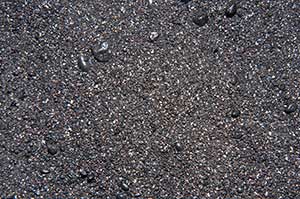 |
Black Sand
The black sand that makes up the famous Hawaiian black sand beaches is made out of basalt. These beaches can form rapidly when molten lava meets the cold ocean water in an explosive confrontation. The shattered volcanic rock is further broken down as it is smashed together by the waves. Black sand beaches can be relative short lived. This photo shows the black sand of Maui's Pa'iloa beach. |
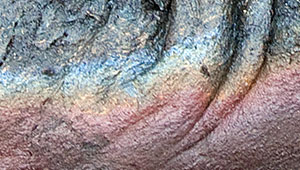 |
Iridescent Colors
New pahoehoe lava has a black shiny, paper-thin crust that can reflect light in iridescent colors similar to a slick of oil on the road. |
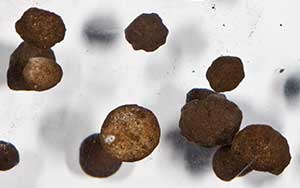 |
Lapilli
These pea-sized fragments form when fine ash coalesces around small nuclei of rock fragments or raindrops within steam-laden explosion clouds. Because they form in turbulent clouds and fall to the earth's surface, accretionary lapilli have been called volcanic hailstones. These lapilli were from during the 1790 explosive eruption of Kilauea. |
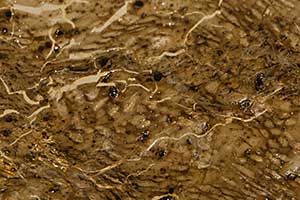 |
Limu o Pele
Limu, or Limu o Pele (Hawaiian for "seaweed of Pele"), consists of thin flakes of basaltic glass that sometimes form when pahoehoe lava pours into the ocean. As waves wash atop exposed streams of lava, some water may become trapped and boil, resulting in delicate steam-filled bubbles of lava. Abrupt chilling and continued expansion of the delicate bubble walls form thin plates and shattered pieces of brownish-green to nearly-clear glass. |
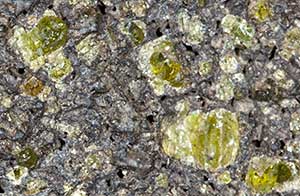 |
Olivine-Rich Lava
This lava specimen was part of a flow that entered the ocean, shattered, and released olivine to form a green sand beach on Mauna Loa's south coast, Hawaii. The heavier olivine particles separated from the other particles by the ocean currents. The green mineral olivine was concentrated to form the unusual green sand beach. |
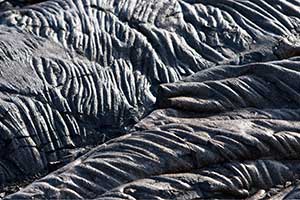 |
Pahoehoe Lava
Pahoehoe is a Hawaiian term for basaltic lava that has a smooth, hummocky, or ropy surface. A pahoehoe flow typically advances as a series of small lobes and toes that continually break out from a cooled crust. The surface texture of pahoehoe flows varies widely, displaying all kinds of bizarre shapes often referred to as lava sculpture. |
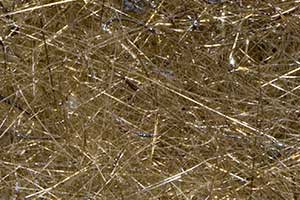 |
Pele's Hair
Thin strands of volcanic glass drawn out from molten lava have long been called Pele's hair, named for Pele, the Hawaiian goddess of volcanoes. A single strand, with a diameter of less than 0.5 mm, may be as long as 2 m. The strands are formed by the stretching or blowing-out of molten basaltic glass from lava, usually from lava fountains, lava cascades, and vigorous lava flows (for example, as pahoehoe lava plunges over a small cliff and at the front of an `a`a flow). Pele's hair is often carried high into the air during fountaining, and wind can blow the glass threads several tens of kilometers from a vent. |
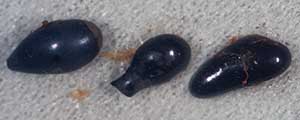 |
Pele's Tears
Small bits of molten lava in fountains can cool quickly and solidify into glass particles shaped like spheres or tear drops called Pele's tears, named after Pele, the Hawaiian goddess of volcanoes. They are jet black in color and are often found on one end of a strand of Pele's hair. |
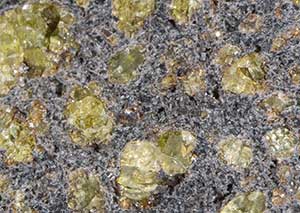 |
Picritic Basalt
This sample of picritic basalt was made at a high temperature of 1200°C (2200°F) about 2 miles underground in the magma chamber of the Ko'olau volcano. The high temperature allowed the large olivine crystals to form. The crystals grew very slowly for years while underground. The blade-like black and white plagioclase crystals formed during and shortly after the eruption of the magma. The rock dates to 2.5 million years ago. |
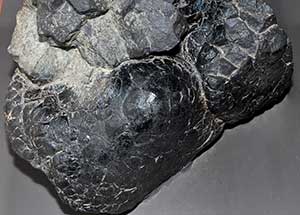 |
Pillow Lava from Loihi Volcano
Much of Loihi's surface is covered with rounded "pillows," the form basalt lava commonly takes when erupted underwater. Parts of three pillows are contained in this specimen. High seawater pressure at the collection depth of 1180 meters retarded the release of gases from the lava, keeping the vesicles, or gas bubbles, small and few in number. The pillows' thin glassy veneer resulted when the hot lava erupted into cold seawater. |
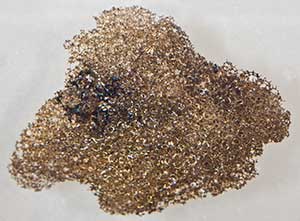 |
Reticulite
Reticulite is basaltic pumice in which nearly all cell walls of gas bubbles have burst, leaving a honeycomb-like structure. Even though it is less dense than pumice, reticulite does not float in water because of the open network of bubbles. The delicate glass threads between the bubbles are so fragile that reticulite was first called "thread-lace scoria" by the great American mineralogist, James Dana. It has also been called limu. |
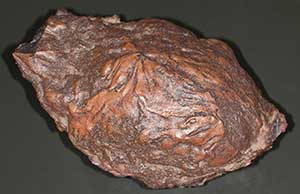 |
Volcanic Bomb
Volcanic bombs are lava fragments that were ejected while viscous (partially molten) and larger than 64 mm in diameter. Many acquire rounded aerodynamic shapes during their travel through the air. Volcanic bombs include breadcrust bombs, ribbon bombs, spindle bombs (with twisted ends), spheroidal bombs, and "cow-dung" bombs. |